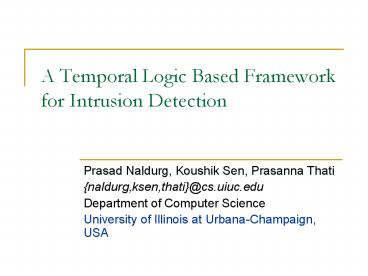A Temporal Logic Based Framework for Intrusion Detection - PowerPoint PPT Presentation
1 / 18
Title:
A Temporal Logic Based Framework for Intrusion Detection
Description:
A Temporal Logic Based Framework for Intrusion Detection ... Smurf Attack ... Absence of Smurf Attack. X. Cookie-Stealing Scenario ... – PowerPoint PPT presentation
Number of Views:41
Avg rating:3.0/5.0
Title: A Temporal Logic Based Framework for Intrusion Detection
1
A Temporal Logic Based Framework for Intrusion
Detection
- Prasad Naldurg, Koushik Sen, Prasanna Thati
- naldurg,ksen,thati_at_cs.uiuc.edu
- Department of Computer Science
- University of Illinois at Urbana-Champaign, USA
2
Intrusion Detection
- Security flaws in complex computer systems and
network seem to be inevitable - Intrusion detection Monitor the system execution
for security violations and take corrective
measures when a violation is detected - Two approaches
- Signature based Look for known attack patterns
- Cant detect previously unknown attacks
- Anomaly based Look for anomalous behaviors
- High false alarm rates
3
A Temporal Logic Based Approach
- Attack patterns are typically temporal relations
between different system events - Specify an attack safe executions as a formula F
in a variant of Linear Temporal Logic (LTL) - System execution provides a trace on which the
formula F is interpreted - Enrich LTL to express real-time constraints and
statistical properties of the expected system
behavior - Use an online monitoring algorithm that monitors
each system events as they occur, and raise an
alarm as soon as a formula is violated
4
Related Work Signature Based Intrusion Detection
- Transition systems and grammars
- Colored Petri Nets by Kumar et al.
- Parallel Grammars by Ko et al.
- Finite Transition Diagrams by Ilgun et al.
- Such descriptions are often cumbersome
- Temporal Logic approach by Roger et al.
- A propositional logic in which one cannot express
real-time constraints and statistical properties - We use a richer logic equipped with data and
relations on them. Useful for specifying
statistical properties.
5
Monid A framework for intrusion detection
6
Eagle By Example
- Monitoring formulas are evaluated over a given
input trace, state by state, checking facts about
the past and generating obligations about the
future. - max Always(Formula F) F AND Next Always(F)
- min Eventually(Formula F) F OR Next
Eventually(F) - min Previously(Formula F) F OR Prev
Previously(F) - Monitor If there is a login then eventually
there is a logout - mon M1 Always((actionlogin) then
Eventually(actionlogout)) .
7
Data Binding
- Monitor Whenever there is a login by any user x
then eventually x logs out. - In LTL with data bindings
- ?((actionlogin) then let k uid in
(actionlogout AND uidk)) - In Eagle
- min Bind(string k) Eventually(actionlogout AND
uidk) - mon M2 Always((actionlogin) then Bind(uid))
Each state contains int action string uid
8
Real Time
- Monitor Whenever there is a login by any user x
then eventually x logs out within 100 units of
time. - min TimedLogout(string k,double t,double ?)
(time-t LEQ ?) AND ((actionlogout AND uidk)
OR - Next
TimedLogout(k,t,?)) - mon M3 Always((actionlogin) then
TimedLogout(uid,time,100))
Each state contains int action string
uid double time
9
Syntax
10
Semantics
11
Monitoring Algorithm Example Execution
mon M Always(x gt 0 ? NextNext(x 0)).
Trace x1 x2 x0 x3
12
Trace Evaluation
13
Smurf Attack
- An attacker sends a forged ICMP echo request
with victims name as sender and sets destination
IP to a broadcast IP address - Monitor log obtained by tcpdump
- max Attack() (typeICMP) AND isBroadcast(ip)
- mon SmurfSafety Always(NOT Attack())
Each state contains int32 ip string type
Absence of Smurf Attack
isBroadcast(ip)true ICMP
X
14
Cookie-Stealing Scenario
- A malicious user hijacks a session by reusing an
old cookie issued to a different IP address - Monitor web-server log
- min SafeUse(string c,int i) ((namec) ! (ipi))
AND Prev SafeUse(c,i) - mon CookieSafe Always(SafeUse(name,ip))
- Also include
- Multi-domain buffer overflow attack which
illustrates our ability to collect statistics at
runtime anomaly detection - Port sweep attack remember finite history and
statistics - Evaluation on DARPA data set
- Explore overheads and expressive power
15
Performance Overhead Port Sweep Attack
16
Performance Overhead Password-Guess Attack
17
Conclusion
- Have proposed a framework for intrusion detection
based on a temporal logic approach - Experimentally evaluated the framework using real
data - Some directions for future research
- Predicting security attacks from otherwise
successful system executions. Useful for
detecting concurrency related attacks. - Distributed monitoring to detect attacks the
involve multiple hosts.
18
Thank You!
- Contact Information
- Prasad naldurg_at_cs.uiuc.edu
- Koushik ksen_at_cs.uiuc.edu
- Prasannaa thati_at_cs.cmu.edu
- Address
- Department of Computer Science, University of
Illinois at Urbana, Champaign, Urbana IL 61801,
USA































